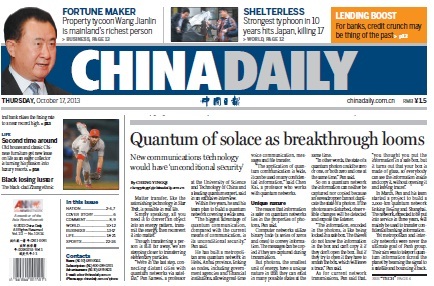New communications technology would have 'unconditional security'
Matter transfer, like the astonishing technology in Star Trek, is possible in real life.
Simply speaking, all you need is to convert an object into an energy pattern, transmit theenergy, then reconvert it into matter.
Though transferring a person is still far away, we are stepping closer to transferring elementaryparticles.
"We're in the last step, connecting distant cities with quantum networks via satellite," PanJianwei, a professor at the University of Science and Technology of China and a leadingquantum expert, said in an exclusive interview.
Within five years, he and his team plan to build a quantum network covering a wide area.
"The biggest advantage of quantum communication, compared with the current means ofcommunication, is its unconditional security," Pan said.
He has built a metropolitan area quantum network in Hefei, Anhui province, linking 46 nodes,including government agencies and financial institutions, allowing real-time voicecommunication, messages and file transfer.
"The application of quantum communication is wide, it can be used on any confidentialinformation," said Chen Kai, a professor who works with quantum networks.
Unique nature
The reason that information is safer on quantum networks lies in the properties of photons, Pan said.
Computer networks utilize binary code (a series of zeros and ones) to convey information. Themessages can be copied if they are captured during transmission.
But photons, the smallest unit of energy, have a unique nature in that they can exist in manypossible states at the same time.
"In other words, the state of a quantum photon could be zero or one, or both zero and one atthe same time," Pan said.
So on a quantum network the information can neither be captured nor copied because aneavesdropper cannot duplicate the state of a photon. If the photons are disturbed, observablechanges will be detected and expose the listener.
"The information, encoded in the photons, is like being locked in a safe box. The thieves do notknow the information in the box and can't copy it if they don't open the box. But if they try toopen it they have to smash the box, which will leave a trace," Pan said.
As for current network transmissions, Pan said that, "you thought you put the information in asafe box, but it turns out that your box is made of glass, so everybody can see the informationinside and copy it, without opening it and leaving traces".
In March, Pan and his team started a project to build a 2,000-km quantum network linkingBeijing and Shanghai. The network, expected to be put into service in three years, will mainlybe used to transfer confidential banking information.
Yet metropolitan and intercity networks were never the ultimate goal of Pan's group. Their aimwas to teleport quantum information across the planet by beaming the signal to a satellite andbouncing it back.
Yet there is no point in developing a satellite quantum communication network if you have noone to talk with. So Pan invited his doctoral tutor and one-time rival Anton Zeilinger.
This year, the team sent photons to an orbiting satellite and detected thousands of the photonsback on Earth.
In June, MIT Technology Review's arXiv Blog reported the experiment as a "small victory in thisquantum space race" between China and Europe.
"What is abundantly clear is that the quantum space race is rapidly heating up. But theembarrassing truth for American science is that the US isn't yet a player in the quantum spacerace (at least not publicly). Perhaps that's something that should change," the author wrote.
In 2016, China plans to launch a satellite dedicated to quantum experiments, the ChineseQuantum Science Satellite, that would put it ahead of the US and Europe.
"The satellite will provide scientific answers to the feasibility of intercontinental quantumteleportation — to make it simple, whether I can talk to my friend in Vienna from Beijing on aquantum phone," Pan said.
A report in Nature magazine said that teleporting photons to a satellite would "establish the firstlinks of a ‘quantum Internet' that harnesses the powers of subatomic physics to create a super-secure global communication network. It will confirm China's ascent in the field, from a bitplayer, little more than a decade ago, to a global powerhouse".
Although the practical application of quantum networks that link every corner on Earth wouldneed more than just one satellite, Pan is happy to see China being "one step ahead of worldcompetitors".
"There is fierce international competition in quantum communication, especially from the USand Germany," Pan said.
"Quantum communication represents a significant direction of technological development, andthe best thing we can do is to think big, think ahead and plan in advance."
chengyingqi@chinadaily.com.cn

ChinaDaily 2013-10-17 头版 http://www.chinadaily.com.cn/china/2013-10/17/content_17038203.htm